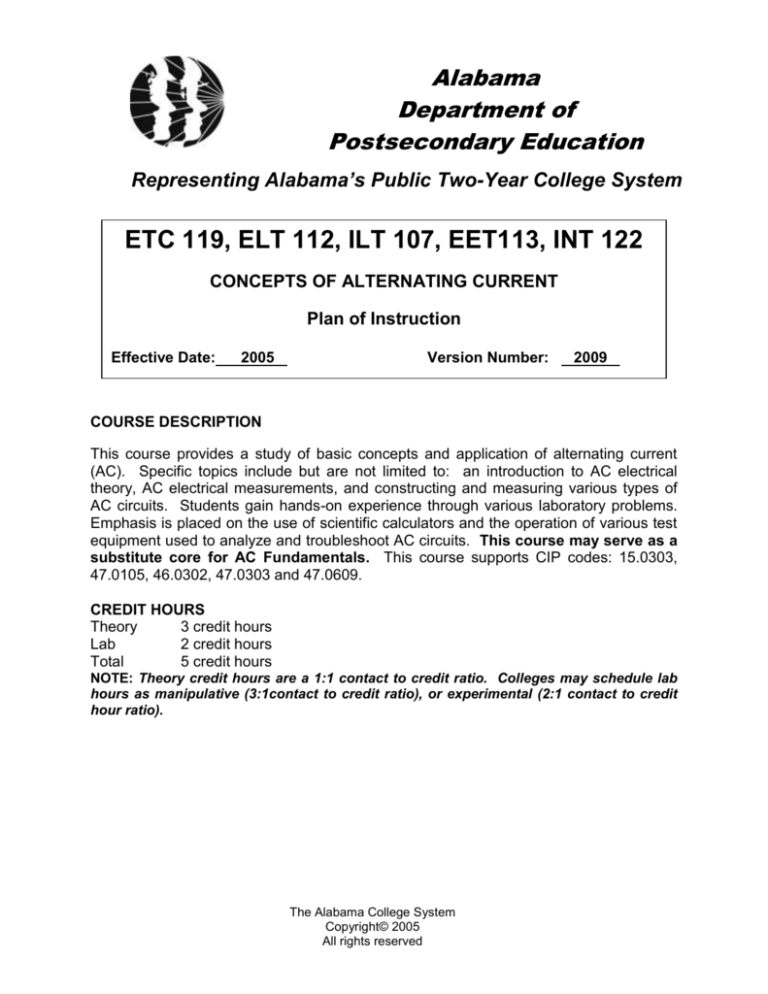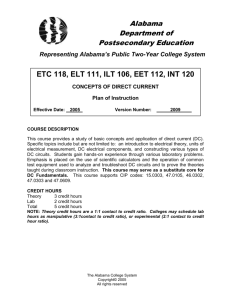
Alabama
Department of
Postsecondary Education
Representing Alabama’s Public Two-Year College System
ETC 119, ELT 112, ILT 107, EET113, INT 122
CONCEPTS OF ALTERNATING CURRENT
Plan of Instruction
Effective Date:
2005
Version Number:
2009
COURSE DESCRIPTION
This course provides a study of basic concepts and application of alternating current
(AC). Specific topics include but are not limited to: an introduction to AC electrical
theory, AC electrical measurements, and constructing and measuring various types of
AC circuits. Students gain hands-on experience through various laboratory problems.
Emphasis is placed on the use of scientific calculators and the operation of various test
equipment used to analyze and troubleshoot AC circuits. This course may serve as a
substitute core for AC Fundamentals. This course supports CIP codes: 15.0303,
47.0105, 46.0302, 47.0303 and 47.0609.
CREDIT HOURS
Theory
3 credit hours
Lab
2 credit hours
Total
5 credit hours
NOTE: Theory credit hours are a 1:1 contact to credit ratio. Colleges may schedule lab
hours as manipulative (3:1contact to credit ratio), or experimental (2:1 contact to credit
hour ratio).
The Alabama College System
Copyright© 2005
All rights reserved
Concepts of Alternating Current
ETC 119, ELT 112, ILT 107, EET113, INT 122
PREREQUISITE COURSES
Determined by college unless stated otherwise
CO-REQUISITE COURSES
Determined by college unless stated otherwise
INDUSTRY/PROFESSIONAL COMPETENCIES
Practice safety.
Explain concepts related to AC electrical theory.
Use AC electrical measurement instruments.
Construct and analyze various AC circuits.
GENERAL INSTRUCTIONAL OBJECTIVES
The cognitive objectives for this course are for each student to comprehend
fundamentals of AC.
The psychomotor objective of this course is for each student to apply foundational
knowledge to AC electronic problems and exercises encountered in class.
INDUSTRY/PROFESSIONAL COMPETENCIES/STUDENT PERFORMANCE
Unless otherwise indicated, evaluation of student’s attainment of cognitive and
performance objectives is based on knowledge gained from this course. During
performance evaluations, students will be provided necessary tools, equipment,
materials, specifications, and any other resources necessary to accomplish the task.
Specifications may be in the form of, but not limited to, manufacturer’s specifications,
technical orders, regulations, national and state codes, certification agencies, locally
developed lab assignments, or any combination of specifications.
ACS © 2005
All rights reserved
2
Concepts of Alternating Current
ETC 119, ELT 112, ILT 107, EET113, INT 122
MODULE A – INTRODUCTION TO AC ELECTRICAL THEORY
INDUSTRY/PROFESSIONAL
COMPETENCIES
A1.0 Practice safety. (2c)
A2.0 Explain concepts related to
AC electrical theory. (B)
STUDENT PERFORMANCE OBJECTIVES
A1.1 Perform lab activities in a safe manner.
A1.2 Select and safely use the appropriate tools.
A2.1 This competency is measured cognitively.
A1.1.1 Explain safety rules and procedures for lab activities.
A1.2.1 Explain the proper use of basic electrical tools.
A1.2.2 Explain inspection procedures for tools.
KSA
Indicator
b
b
b
A2.1.1 Define terms associated with AC electricity.
A2.1.2 Identify basic symbols used with AC electricity.
A2.1.3 Explain magnetism.
A2.1.4 Explain magnetic units.
A2.1.5 Explain electromagnetic induction.
A2.1.6 Identify a sine wave.
A2.1.7 Describe sine wave generation.
A2.1.8 Define measurements of a sine wave.
A2.1.9 Analyze basic AC circuits using Ohm’s Law.
A2.1.10 Calculate sine wave measurements.
A2.1.11 Explain AC power law formulas.
A2.1.12 Calculate circuit values using AC power law.
A
A
B
B
B
A
B
B
C
C
B
C
ENABLING OBJECTIVES
MODULE B – AC ELECTRICAL MEASUREMENTS
INDUSTRY/PROFESSIONAL
COMPETENCIES
B1.0 Use AC electrical
measurement instruments.
(2c)
STUDENT PERFORMANCE OBJECTIVES
B1.1 Use various instruments to measure AC
quantities.
ENABLING OBJECTIVES
B1.1.1 Identify components of an oscilloscope.
B1.1.2 Explain the operation of an oscilloscope.
B1.1.3 Differentiate between the measurements of an oscilloscope and other
electric measurement instruments.
ACS © 2005
All rights reserved
KSA
Indicator
a
c
C
3
Concepts of Alternating Current
ETC 119, ELT 112, ILT 107, EET113, INT 122
MODULE C – AC CIRCUITS
INDUSTRY/PROFESSIONAL
COMPETENCIES
C1.0 Construct and analyze
various AC circuits. (2c)
STUDENT PERFORMANCE OBJECTIVES
C1.1 Construct RC circuits and measure electrical
quantities.
C1.2 Construct RL circuits and measure electrical
quantities.
C1.3 Construct RLC circuits and measure
electrical quantities.
ENABLING OBJECTIVES
C1.1.1 Identify schematics and symbols for various AC circuits.
C1.1.2 Explain the characteristics of capacitors.
C1.1.3 Calculate total capacitance in series and parallel.
C1.1.4 Calculate capacitive reactance.
C1.1.5 Calculate impedance.
C1.1.6 Calculate phase angle.
C1.1.7 Calculate current.
C1.1.8 Calculate voltage.
C1.1.9 Calculate power factors.
C1.1.10 Calculate time constants.
C1.2.1 Explain the characteristics of inductors.
C1.2.2 Calculate total inductance in series and parallel.
C1.2.3 Calculate inductive reactance.
C1.2.4 Calculate impedance.
C1.2.5 Calculate phase angle.
C1.2.6 Calculate current.
C1.2.7 Calculate voltage.
C1.2.8 Calculate power factors.
C1.2.9 Calculate time constants.
C1.2.10 Explain the turns ratio of transformers.
C1.2.11 Define electrical characteristics of transformers.
C1.3.1 Calculate impedance.
C1.3.2 Calculate phase angle.
C1.3.3 Calculate current.
C1.3.4 Calculate voltage.
C1.3.5 Calculate power factors.
C1.3.6 Calculate resonance.
C1.3.7 Describe filters.
C1.3.8 Measure bandwidth.
ACS © 2005
All rights reserved
KSA
Indicator
A
B
C
C
C
C
C
C
C
C
B
C
C
C
C
C
C
C
C
B
B
C
C
C
C
C
C
B
C
4
Concepts of Alternating Current
ETC 119, ELT 112, ILT 107, EET113, INT 122
COURSE CONTENT OUTLINE
MODULE A – INTRODUCTION TO AC ELECTRICAL THEORY
Safety and tool use
Terms
Symbols
Magnetism
Magnetism characteristics
Magnetic units
Electromagnetic induction
Sine wave measurements
Peak to peak
Peak
RMS
Average
Period
Frequency
AC Ohm’s Law
Formulas
Calculations
AC Power Law
Formulas
Calculations
MODULE B - AC ELECTRICAL MEASUREMENT
Oscilloscope
Multi-meter
Other devices
MODULE C – AC CIRCUITS
Schematics and symbols
Capacitive circuits
Capacitive reactance
Inductive circuits
Inductive reactance
Transformers
Turns ratio
Primary/secondary
Electrical characteristics
Resistive, capacitive, inductive circuits
Time constants
RC
LR
Resonant circuits
Types and functions of filters
Measurement and calculations
Circuit construction techniques
Troubleshooting
ACS © 2005
All rights reserved
5
Concepts of Alternating Current
ETC 119, ELT 112, ILT 107, EET113, INT 122
RECOMMENDED METHODS OF EVALUATION: The tables of specifications below
identify the number of cognitive (knowledge) enabling objectives and psychomotor
(performance) objectives per module. Instructors should develop sufficient
numbers of test questions to ensure complete coverage of each cognitive and/or
psychomotor objectives identified in each module. For cognitive objectives, use
appropriate written test type based on the complexity indicator for each objective.
Create comprehensive, checklist evaluations for each psychomotor objective.
Facts/Nomenclature (A/a):
Multiple Choice, Fill-in, List, Matching, Alternative
Response (true/false or yes/no)
Principles/Procedures (B/b): Multiple Choice, Fill-in, List, Short Answer
Analysis/Operating Principles (C/c): Multiple Choice, Short Answer, Essay
Evaluation/Complete Theory (D/d): Multiple Choice, Short Answer, Essay
ENABLING OBJECTIVES TABLE OF SPECIFICATIONS
Cognitive Domain
Module A
Module B
Module C
Total
Facts/
Nomenclature
Principles/
Procedures
Analysis/
Operating
Principles
Evaluation/
Complete
Theory
Total
Objectives
3
1
1
5
9
5
14
3
2
23
28
-
15
3
29
47
PERFORMANCE OBJECTIVES TABLE OF SPECIFICATIONS
Psychomotor Domain
Module A
Module B
Module C
Total
ACS © 2005
All rights reserved
Limited
Proficiency
1
Partially
Proficient
2
Proficient
3
Highly
Proficient
4
Total
Objectives
0
2
1
3
6
0
0
2
1
3
6
6
Concepts of Alternating Current
ETC 119, ELT 112, ILT 107, EET113, INT 122
Knowledge, Skills, and Abilities (KSA) Indicators
Performance
Ability
Value
4
Key Word(s)
Highly
Proficient
3
Proficient
2
Knowledge
Knowledge of Skills
1
d
c
Partially
Proficient
Limited
Proficiency
Complete
Theory
Operating
Principles
b
Procedures
a
Nomenclature
D
Evaluation
C
Analysis
B
Principles
A
Facts
Definition
Can do the complete competency quickly and accurately. Can tell or
show others how to do the competency.
Can do all parts of the competency. Needs only a spot check of
completed work
Can do most parts of the competency. Needs help only on hardest
parts.
Can do simple parts of the competency. Needs to be told or shown
how to do most of the competency.
Can predict, isolate, and resolve problems about the competency
Can identify why and when the competency must be done and why
each step is needed.
Can determine step-by-step procedures for doing the competency.
Can name parts, tools, and simple facts about the competency.
Can evaluate conditions and make proper decisions about the
subject.
Can analyze facts and principles and draw conclusions about the
subject.
Can identify relationship of basic facts and state general principles
about the subject.
Can identify basic facts and terms about the subject
Alpha Scale Values - Any item with an upper case letter (A, B, C, D) by itself is taught as general information on a
topic. This information may be related to the competency or encompass multiple competencies. Examples might
include mathematical computations or knowledge of principles such as Ohm’s Law.
A lower case letter indicates a level of ”Knowledge of Skills." Individuals are taught information pertaining to performing
a competency . These may be indicated alone or in conjunction with a numerical scale value. A lower case letter by
itself indicates the individual is not required to perform the task-just know about the task. (example: Can state or
explain procedures for doing a task).
Numerical Scale Values - The numbers reflect the levels the individual will be able to perform a competency. Number
values are always accompanied by lower case letters (i.e. 1a, 2b, 3c...etc.) in order to specify the level of knowledge of
skills associated with the competency.
Example: An individual with a competency with a scale indicator of 3b has received training of knowledge of skills
whereby he or she can determine the correct procedures and perform with limited supervision; only requiring evaluation
of the finished product or procedure.
NOTE: Codes indicate terminal values.
ACS © 2005
All rights reserved
7
Concepts of Alternating Current
ETC 119, ELT 112, ILT 107, EET113, INT 122
Northeast Alabama Community College
Form 1: Learning Outcomes Attachment for Career/Technical Courses
(Instructor Evaluation of Course)
Faculty regularly review the extent to which the course and program learning outcomes identified in a
course syllabus are being attained by students who complete the course. Each syllabus identifies the
assessment method that will be used to demonstrate student mastery of the desired learning outcomes
for that course. Before teaching a course, faculty should review the syllabus to understand how the
program learning outcomes will be evaluated. Once the course is complete, this form is used by the
instructor to report how well students demonstrated mastery of those course learning (and by extension,
program learning) outcomes.
Course Prefix & No.: ILT 107, INT 122
Instructor:
Semester:
Type of Delivery – Mark One*:
Course Title: Concepts of Alternating
Current
Date:
Section Number(s):
Dual Enrollment
Online
Traditional
*Double click on the appropriate box. When the form field menu appears, select “checked” under Default value.
Note: To insert or delete rows on the table, click on Table on the tool bar.
Learning
Outcome
(Industry or Professional
Competency)
Practice safety.
Explain concepts
related to electrical
theory.
Use AC electrical
measurement
instruments.
Identify AC electrical
components.
Evaluation Method
Evaluation Results
Explain how each learning outcome for this course is
assessed.
Of the students who earned a grade of C or
better for the course, what percentage
demonstrated attainment of the stated
outcomes?
The student will demonstrate safe
practices in the lab setting as
documented by the instructor on a
standard checklist.
The student will demonstrate knowledge
of electrical theory by successfully
answering selected items on an exam
with at least 80% proficiency.
The student will measure voltage, current,
and resistance of a simple circuit in a
designated lab exercise with at least 80%
accuracy.
The student will identify AC electrical
components by correctly responding to
selected test items with at least 80%
proficiency.
Use of Evaluation Results
Explain how evaluation results will be used to improve the course.
*Reviewed:
Division Chair or Program Supervisor
Date
*To be completed by Division Chair or Program Supervisor Only
ACS © 2005
All rights reserved
8










